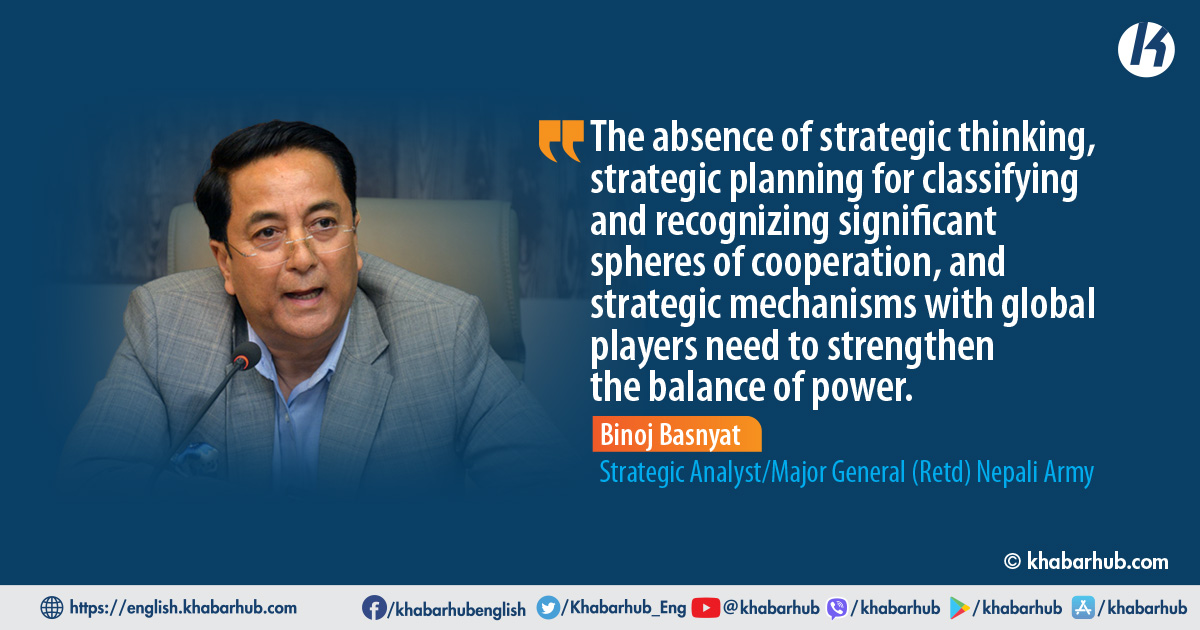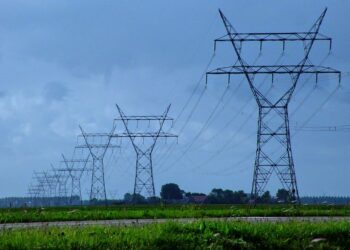In the ‘World System theory’, Nepal falls under ‘Periphery’ countries, relating to its dependence and exploitation by developed countries due to weak state institutions, which align with the ‘dependent theory’, despite state leaders boasting about the ‘modernization theory’.
There can be no denial that Nepal functions as a buffer state, amidst potential power competition between China and India.
Prime Minister Puspa Kamal Dahal Prachanda visited China from 23rd to 30th September, following the United Nations General Assembly (UNGA) summit and chairing the Least Developed Countries (LDC) conference in New York. Additionally, Nepal is a member of the Landlocked Developing Countries (LLDC).
China’s white paper on global governance, titled “Global Community of Shared Future” (GCSF), along with the 13-point joint statement, was issued on 26th September. The GCSF, announced by President Xi Jinping in 2013, marked a decade of its inception, alongside the Belt and Road Initiative (BRI) in the same year.
While the Nepal-China joint statement forms the basis of diplomatic undertakings, informal talks could have addressed other unofficial strategic concerns, typically acquiring national attention and consensus guided by constitutional arrangements and national policies.
The joint statement summarizes the agreements and understandings, along with the Memorandums of Understanding.
The Nepal-China relationship is strategic, with three pillars: political-security, political-economy, and socio-cultural undertakings forming the political-economic-security-diplomatic nexus, as emphasized during the visit.
Journey of Diplomacy in the 21st Century
The diplomatic voyage in the 21st-century geostrategic milieu involves promoting multilateralism, fostering greater
The initiative “Lighting Up the Future” included the launch of the ‘China-Nepal Political Parties’ Livelihood and Poverty Alleviation Action in Nepal’ and the unveiling of “Vibrant Village,” a demonstration project by the China-South Asian Countries Poverty Alleviation and Cooperative Development Center. democracy in international relations, and rendering global governance more just and equitable.
It comprehends the unipolar security order, multipolar economic order, and the indeterminate digital order.
Strengthening cooperation within the UN framework and other multilateral mechanisms is crucial to uphold the common interests of developing countries or the Global South.
There is a need to support the multilateral trading system and oppose protectionism.
Governments and leaders are increasingly constrained by domestic strategies and geopolitical guiding principles, influenced by the multitude in democracies and other influential nations.
Observing current world geopolitical headlines and conflicts across Africa, Asia, the Caribbean, Europe, Latin America, and the Middle East underscores this point.
China has vowed to collaborate with all aspects of globalization — economic, political, and cultural — to foster a more open, inclusive, balanced, and beneficial world.
Simultaneously, it aims to promote global and regional peace, security, development, and prosperity, aspiring to build a community with a shared future for mankind.
Thus, the situation also concerns US engagement and India’s traditionally influential diplomacy.
Decoding Strategic Significances
Strategically, shifting from ‘policy’ to ‘principle’ on the “One China” issue is a transferal to a rule that must be adhered to, whereas policy serves as a guide. Both are essential in the prudent management of the legal system.
Interconnectedly, principles establish an undeniable notion, ensuring that policies are properly ratified to achieve the anticipated optimal outcomes.
The distinction between principle and policy lies in the fact that a principle is imperative, requiring adherence, while a policy is a guideline that can be adopted in international relations.
Thus, a principle restricts unacceptable rules or diplomatic behavior, while policy merely guides, allowing for the freedom of choice in adhering to those guidelines.
Secondly, strengthening China in Tibetan matters has four statements directly referencing Tibetan concerns.
“The Nepali side reiterates that Tibet affairs are China’s internal affairs and that Nepal will never allow any separatist activities against China on its soil.”
The fundamental perception remains unchanged, but the joint statement formulation separates Tibet from Taiwan, unlike the two joint statements during Xi Jinping’s visit to Nepal in 2019 and Prime Minister KP Sharma Oli’s visit to China in 2018.
It states, “The Nepali side reiterated its firm commitment to the One-China policy, with Tibet and Taiwan affairs being China’s internal affairs, and its determination not to allow any anti-China activities on its soil.”
Thirdly, supporting the Global Development Initiative (GDI) entails acknowledging the other five initiatives and aligning with the Chinese global governance vision, the GCSF, making Nepal the 61st nation to join.
Nepal has already been part of the 154 BRI members, constituting almost 80 percent of the UN since 2017.
This holds strategic implications and geopolitical orientations, especially considering India’s proposal for an India-Middle East-Europe Economic Corridor (IMEEC) in the Group of Twenty nations (G20) summit.
IMEEC is set to be a component of the Partnership for Global Infrastructure and Investment (PGII), announced in June 2022 during the 48th Group of Seven nations (G7) summit, founded on the trust principles of the ‘Blue Dot Network’.
This reconsiders the Build Back the World Better (B3W) doctrine, known as the Biden doctrine. PGII, like GDI, aims to accelerate progress toward achieving the Sustainable Development Goals.
Lastly, expediting the ratification of the China-Nepal Treaty on Mutual Legal Assistance in Criminal Matters (CN-MLAT) is intended to counter bilateral crimes and other challenges by enhancing cooperation in law enforcement and mutual legal assistance in criminal matters.
However, for Nepal and China, this determination has transnational implications, particularly concerning Tibetan matters.
Simultaneously, Nepal is bound by international human rights law, where the principle of non-refoulement guarantees that no one should be returned to a country where they face torture, cruel, inhuman, or degrading treatment or punishment, and other irreparable harm.
Bilateral and multilateral Mutual Legal Assistance Treaties (MLAT) practices are already in place, with the ASEAN MLAT coming into force in 2013, initiated in 2002.
Soft Power in Geopolitical Advancements
The Trans-Himalayan Multi-Dimensional Connectivity Network (THMDCN) is strengthening through the advancement of strategic connectivity, new infrastructure constructions, energy cooperation, and the enhancement of people-to-people relations.
China will undertake emergency management and disaster prevention, reduction, and relief in Nepal by offering technical assistance and training for the National Emergency Operation Center Project’s information platform.
Air routes linking different cities, such as Pokhara and Bhairahawa, will establish a closer connection within Nepal.
The initiative “Lighting Up the Future” included the launch of the ‘China-Nepal Political Parties’ Livelihood and Poverty Alleviation Action in Nepal’ and the unveiling of “Vibrant Village,” a demonstration project by the China-South Asian Countries Poverty Alleviation and Cooperative Development Center.
These projects aim to alleviate poverty, foster development, improve livelihoods, and revitalize rural areas.
China is committed to assisting Nepal’s transition from a landlocked to a land-linked country, supporting the multilateral trading system, and opposing protectionism.
Trade and transit facilities will be expanded, with new ones being opened and existing ones being repaired for both passengers and cargo transportation in the eastern, central, and western regions of Nepal.
Maintenance of roadways in the central part, linking to Kathmandu, has been prioritized, along with the feasibility study of the Jilong/Keyrung-Kathmandu cross-border railway, and assistance in training railway professionals.
A Memorandum of Understanding (MoU) has been established to create a joint technical team tasked with reviewing and modifying the Trade and Payment Agreement, granting zero-tariff treatment to 98 percent of taxable products from Nepal.
Energy connectivity through hydropower and cross-border transmission lines, along with associated substations, will be realized under the ‘China-Nepal Electric Power Cooperation Plan’ during the second meeting of the Joint Implementation Mechanism.
The mechanism will facilitate exchanges and cooperation in various fields including hydropower, wind power, solar power, biomass power, and hydrogen.
Moreover, the construction of the Jilong/Keyrung-Rasuwagadhi-Chilime 220 KV Cross-Border Power Transmission line is set to commence. China will supply grid power to electrify remote villages in northern Nepal, originating from the Xizang Autonomous Region of China.
Additionally, considerations are being made to provide equipment or technology on commercial terms.
Enhancing people-to-people relationships will involve youth exchanges, cooperation between scholars, students, artists, and private sector entrepreneurs.
Exchanges will focus on Science and Technology, Telecommunication, culture, radio and television, think tanks, digital economy, digital infrastructure, and artificial intelligence, among other areas.
China will also support the promotion of the Chinese language in schools through cultural exchanges and Confucius institutes.
The year 2025 has been declared as the Nepal Visit Year in China, aimed at promoting Chinese tourism in Nepal.
The guiding belief should be one of multilateralism and minilateralism, respecting international obligations to avoid diplomatic complexities, particularly with regard to the China-Nepal Treaty on Mutual Legal Assistance in Criminal Matters (CN-MLAT).
Furthermore, establishing sister city relationships between various cities will promote cooperation in improving livelihoods and revitalizing rural areas.
A Boundary Contact System will be implemented at three levels to enhance border management and cooperation.
This system will facilitate the inspection of the Nepal-China border and assist law enforcement agencies in strengthening information exchange and capacity building among their institutions.
China will undertake emergency management and disaster prevention, reduction, and relief in Nepal by offering technical assistance and training for the National Emergency Operation Center Project’s information platform.
A Traditional Chinese Medicine Center providing free medical treatment, personnel training, and medical services will be established in Kathmandu.
Conclusion
The political oligarchy’s inclination to employ foreign policy has been marred by kleptocracy, driven by greed and fear, encompassing territorial and identity insecurities, hindering domestic power for electoral concerns.
This situation is not only limited to the Nepal Communist Party Maoists, led by Prachanda, but extends to major political parties seeking to reinforce their political positions.
Prachanda’s political maneuvers are characterized by a ‘dual loyalty’ appeal, aiming to adopt a neutral political stance that emphasizes nationalism and non-belligerence, as well as the pronouncement of an alternative route to secure supply lines and reduce dependencies with India.
This approach takes advantage of the Indo-Sino regional bipolarity and Sino-US rivalry.
The absence of strategic planning, classification, and recognition of significant spheres of cooperation, as well as the lack of strategic mechanisms with global players, need to be addressed to strengthen the balance of power and prioritize the improvement of the Nepalese people’s livelihood over an insecurity-driven policy of deliberate ambiguity.
Nepal is moving forward with divergent foreign and domestic policy objectives, intending to leverage risk aversion to support a deterrence strategy for maintaining strategic autonomy and averting the expansion of autocratic politics.
Together with joining the Group of Friends of the Global Development Initiative (GDI), the finalization of the Belt and Road Initiative (BRI) implementation plan, and the resolution of border issues and law enforcement matters, Nepal aims to promote tourism, traditional medical cooperation, youth and scholar exchanges, and trade and transit issues.
The Nepal-China relationship extends beyond bilateral agreements to encompass political, economic, and cultural relationships with multilateral implications and geopolitical significance.
These efforts may complicate the balance of threat theory of neutrality.
A roadmap for Nepal’s journey towards stability and prosperity must be anchored and declared as “forging ahead together,” with a vision set for 2040.
The guiding belief should be one of multilateralism and minilateralism, respecting international obligations to avoid diplomatic complexities, particularly with regard to the China-Nepal Treaty on Mutual Legal Assistance in Criminal Matters (CN-MLAT).
Initiatives under the Global Community of Shared Future (GCSF) and the Partnership for Global Infrastructure and Investment (PGII) present an opportunity for low and middle-income countries in the Global South, including Nepal, to meet their needs, as the world faces the potential eruption of a ‘Hot War’ or a ‘Cold War 2.0’ with blocs.
PGII is committed to mobilizing USD 200 billion by 2027, aligning with the need for USD 40 trillion worth of infrastructure in developing countries by 2035, supported by private sector investment that prioritizes climate, health security, digital technology, and gender equity and equality.
Nepal’s strategic posture, characterized by foreign policy ambiguity and political confusion, has been a source of distrust.
Nepal needs a coherent strategy, along with national unity in its economic endeavors and political consensus on foreign policy, underpinned by a strategic national development plan and deterrence posture.
Nepal’s diplomatic approach to circumvent the expansion of Xi Jinping’s thoughts (XJT) is essential to avoid reckless confrontations.
This moment or decade presents an opportunity for Nepal to emulate the foreign policy maneuvers of European small states during the Cold War and the sudden foreign policy shifts of Finland and Sweden in response to Russian aggression.
Nepal must strategize to address what such moves might entail for its future, in the context of the ongoing debate about altering the orchestrators of the “non-alignment” policy, recognizing that ‘non-alignment’ cannot persist in the Global South under the same circumstances.
Six factors need to be considered by Nepal as strategic autonomy faces an uncertain future, including ‘Hedging,’ ‘Bandwagoning,’ or ‘Balancing’ foreign policy choices, accounting for its geographical location, geopolitical complexities, democratic politics, dependent national economy, political instability, and the fear and greed-driven administrative system.
The Nepal-China relationship extends beyond bilateral agreements to encompass political, economic, and cultural relationships with multilateral implications and geopolitical significance.
(The author is a Strategic Analyst, Major General (Retd) of the Nepali Army, and is associated with Rangsit University, Thailand)









Comment